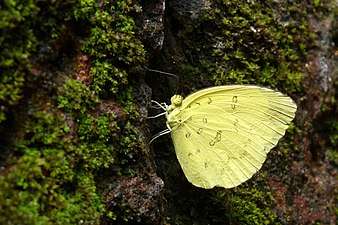Eurema blanda
Eurema blanda, the three-spot grass yellow,[3][4] is a small butterfly of the family Pieridae which is found in Sri Lanka, India and southeast Asia.[3][4][1][2]
| Three-spot grass yellow | |
|---|---|
 | |
| In Kerala, India | |
| Scientific classification | |
| Kingdom: | Animalia |
| Phylum: | Arthropoda |
| Class: | Insecta |
| Order: | Lepidoptera |
| Family: | Pieridae |
| Genus: | Eurema |
| Species: | E. blanda |
| Binomial name | |
| Eurema blanda Boisduval, 1836 | |
| Synonyms | |
Description
Wet form: Male. Upper-side lemon-yellow. Fore-wing with the outer marginal black band anteriorly broader than in Sri Lankan specimens of Eurema hecabe, the posterior end shorter and its inner edge outwardly oblique. Hind-wing with a moderately broad black outer band. Underside. Both wings with more or less defined ordinary markings of wet form. Fore-wing with three marks in the cell, in addition to the discocellular. No sub-apical patch. Female. Not seen.
Intermediate form: Male. Not seen. Female. Upper-side. Fore-wing with similar outer band to the wet form. Hind-wing with a broad black outer marginal band. Underside with slightly-defined ordinary brown markings as in wet form. Fore-wing with a brown sub-apical patch.
Dry form: Smaller than in wet form. Male. Upper-side. Fore-wing with narrower outer marginal band, its posterior end much smaller. Hind-wing with a slender outer band. Underside. Both wings with similar ordinary markings to the wet form. Fore-wing with a more or less defined sub-apical patch. Female. Upper-side. Fore-wing with a broader black outer band than in male. Hind-wing with a much broader outer band than in male. Underside. Both wings similar to male.
Extreme Dry form: Male not seen. Female. Upper-side. Fore-wing with a broad black outer band, its posterior portion angled obliquely outward from the lower median veinlet. Hind-wing with a moderately broad outer band. Underside. Both wings with ordinary markings as in Ddry form. Fore-wing with a prominent almost complete quadrate apical brown patch.
Food plants
Caesalpinia mimosoides and Bauhinia purpurea.[5]

Notes
-

-

- Varshney, R.K.; Smetacek, Peter (2015). A Synoptic Catalogue of the Butterflies of India. New Delhi: Butterfly Research Centre, Bhimtal & Indinov Publishing, New Delhi. p. 68. doi:10.13140/RG.2.1.3966.2164. ISBN 978-81-929826-4-9.
- Savela, Markku. "Eurema blanda (Boisduval, 1836)". Lepidoptera and Some Other Life Forms. Retrieved July 1, 2018.
- Kunte, K. (2006). Additions to known larval host plants of Indian butterflies. Journal of the Bombay Natural History Society 103(1):119-120.
References
- Evans, W.H. (1932). The Identification of Indian Butterflies (2nd ed.). Mumbai, India: Bombay Natural History Society.
- Gaonkar, Harish (1996). Butterflies of the Western Ghats, India (including Sri Lanka) - A Biodiversity Assessment of a Threatened Mountain System. Bangalore, India: Centre for Ecological Sciences.
- Gay, Thomas; Kehimkar, Isaac David; Punetha, Jagdish Chandra (1992). Common Butterflies of India. Nature Guides. Bombay, India: World Wide Fund for Nature-India by Oxford University Press. ISBN 978-0195631647.
- Kunte, Krushnamegh (2000). Butterflies of Peninsular India. India, A Lifescape. Hyderabad, India: Universities Press. ISBN 978-8173713545.
- Wynter-Blyth, Mark Alexander (1957). Butterflies of the Indian Region. Bombay, India: Bombay Natural History Society. ISBN 978-8170192329.
External links
| Wikimedia Commons has media related to Eurema blanda. |
- "Life cycle of the Three-spot Grass Yellow (Eurema blanda)". Nature Magnified. Retrieved July 6, 2016.